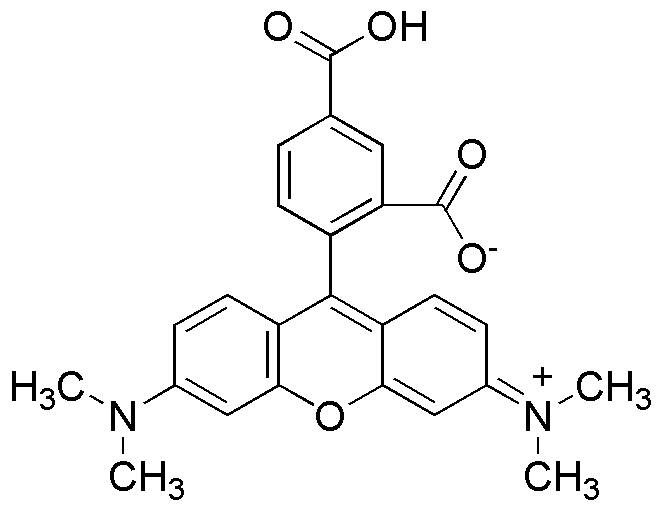5-Carboxy-tetramethylrhodamine is widely utilized in research focused on:
- Fluorescent Labeling: This compound is commonly used as a fluorescent dye in biological research, allowing scientists to tag and visualize proteins and other biomolecules in live cells.
- Imaging Techniques: It plays a crucial role in advanced imaging techniques such as fluorescence microscopy, providing high-resolution images that help researchers study cellular processes in detail.
- Flow Cytometry: The compound is employed in flow cytometry applications, enabling the analysis of cell populations based on their fluorescent characteristics, which is vital in immunology and cancer research.
- Drug Development: In pharmaceutical research, it aids in tracking drug delivery and distribution within biological systems, enhancing the understanding of pharmacokinetics and drug efficacy.
- Environmental Monitoring: This chemical is also used in environmental science to trace pollutants and study their interactions in ecosystems, contributing to ecological research and conservation efforts.
Informations générales
Propriétés
Sécurité et réglementation
Applications
5-Carboxy-tetramethylrhodamine is widely utilized in research focused on:
- Fluorescent Labeling: This compound is commonly used as a fluorescent dye in biological research, allowing scientists to tag and visualize proteins and other biomolecules in live cells.
- Imaging Techniques: It plays a crucial role in advanced imaging techniques such as fluorescence microscopy, providing high-resolution images that help researchers study cellular processes in detail.
- Flow Cytometry: The compound is employed in flow cytometry applications, enabling the analysis of cell populations based on their fluorescent characteristics, which is vital in immunology and cancer research.
- Drug Development: In pharmaceutical research, it aids in tracking drug delivery and distribution within biological systems, enhancing the understanding of pharmacokinetics and drug efficacy.
- Environmental Monitoring: This chemical is also used in environmental science to trace pollutants and study their interactions in ecosystems, contributing to ecological research and conservation efforts.
Documents
Fiches de données de sécurité (FDS)
La FDS fournit des informations de sécurité complètes sur la manipulation, le stockage et l’élimination du produit.
Spécifications du produit (PS)
Le PS fournit une description complète des propriétés du produit, notamment sa composition chimique, son état physique, sa pureté et les exigences de stockage. Il détaille également les plages de qualité acceptables et les applications prévues du produit.
Certificats d'analyse (COA)
Recherchez des certificats d'analyse (COA) en saisissant le numéro de lot du produit. Les numéros de lot et de lot se trouvent sur l'étiquette d'un produit, après les mots « Lot » ou « Lot de fabrication ».
Numéro de catalogue
Numéro de lot/série
Certificats d'origine (COO)
Ce certificat d'exploitation confirme le pays dans lequel le produit a été fabriqué, et détaille également les matériaux et composants utilisés et s'il est issu de sources naturelles, synthétiques ou autres sources spécifiques. Ce certificat peut être requis pour les douanes, le commerce et la conformité réglementaire.
Numéro de catalogue
Numéro de lot/série
Fiches de données de sécurité (FDS)
La FDS fournit des informations de sécurité complètes sur la manipulation, le stockage et l’élimination du produit.
DownloadSpécifications du produit (PS)
Le PS fournit une description complète des propriétés du produit, notamment sa composition chimique, son état physique, sa pureté et les exigences de stockage. Il détaille également les plages de qualité acceptables et les applications prévues du produit.
DownloadCertificats d'analyse (COA)
Recherchez des certificats d'analyse (COA) en saisissant le numéro de lot du produit. Les numéros de lot et de lot se trouvent sur l'étiquette d'un produit, après les mots « Lot » ou « Lot de fabrication ».
Numéro de catalogue
Numéro de lot/série
Certificats d'origine (COO)
Ce certificat d'exploitation confirme le pays dans lequel le produit a été fabriqué, et détaille également les matériaux et composants utilisés et s'il est issu de sources naturelles, synthétiques ou autres sources spécifiques. Ce certificat peut être requis pour les douanes, le commerce et la conformité réglementaire.


